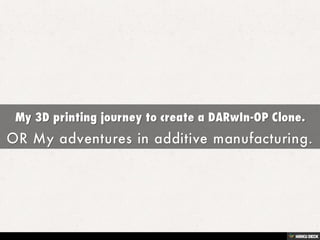
My 3D printing journey to create a DARwIn-OP Clone.
- 1. My 3D printing journey to create a DARwIn-OP Clone. OR My adventures in additive manufacturing.
- 2. I have learned a lot during this project and what follows is some highlights.
- 3. This is my first 3D printer. I have a love hate relationship with the MakerBot CupCake. I never printed out a usable bracket with this printer but it showed me the possibilities of what a printer could do.
- 4. My first usable bracket.
- 5. This bracket took a lot of trial and error
- 6. and a whole new generation of printers to come out for me to print it out.
- 7. I printed it on a first generation UP Plus 3D printer. The UP printer is a FDM printer. "Fused deposition modeling (FDM) is an additive manufacturing technology commonly used for modeling, prototyping, and production applications. FDM works on an "additive" principle by laying down material in layers; a plastic filament or metal wire is unwound from a coil and supplies material to produce a part. The technology was developed by S. Scott Crump in the late 1980s and was commercialized in 1990.
- 8. The term fused deposition modeling and its abbreviation to FDM are trademarked by Stratasys Inc. The exactly equivalent term, fused filament fabrication (FFF), was coined by the members of the RepRap project to give a phrase that would be legally unconstrained in its use. It is also sometimes called Plastic Jet Printing (PJP)."
- 9. I then started my DARwIn-OP project. After lots of trial and error I printed out my first version of the DARWIN-OP. The DARwIn-OP is a open platform robot which made making my clone so much easier.
- 10. DARwIn-OP covers made from nylon by Shapeways. "Strong & Flexible plastic is printed with an SLS process that uses a laser to fuse together nylon powder."
- 11. Selective laser sintering (SLS) is an additive manufacturing technique that uses a laser as the power source to sinter powdered material, aiming the laser automatically at points in space defined by a 3D model, binding the material together to create a solid structure.
- 12. It is similar to direct metal laser sintering (DMLS); the two are instantiations of the same concept but differ in technical details. Selective laser melting (SLM) uses a comparable concept, but in SLM the material is fully melted rather than sintered
- 13. allowing different properties (crystal structure, porosity, and so on). SLS (as well as the other mentioned AM techniques) is a relatively new technology that so far has mainly been used for rapid prototyping and for low-volume production of component parts. Production roles are expanding as the commercialization of AM technology improves.
- 14. After more printing, re-calibration of the servos and redesigning of the brackets. Robby the clone is starting to come around but it still needs some work.
- 15. After a few more iterations he is more stable. ("Iteration is the act of repeating a process with the aim of approaching a desired goal, target or result. Each repetition of the process is also called an "iteration", and the results of one iteration are used as the starting point for the next iteration.")
- 16. First test. Lots of issues but you have to start somewhere.
- 17. Next phase is to explore new materials such as Alumide from I,Materialise. This is also an Selective laser sintering (SLS) process. "Alumide models are constructed from a blend of gray aluminum powder and polyamide, a very fine granular powder. Alumide is a strong, somewhat rigid material that can take small impacts and resist some pressure while being bent. The surface has a sandy, granular look and is slightly porous."
- 18. In the future I will explore parts made on metal printers and SLA printers. So stay tune to my blog for more information on my project.
- 19. Form 1 SLA printer.
- 20. 'Stereolithography (SLA or SL; also known as optical fabrication, photo-solidification, solid free-form fabrication and solid imaging) is an additive manufacturing or 3D printing technology used for producing models, prototypes, patterns, and production parts up one layer at a time by curing a photo-reactive resin with a UV laser or another similar power source.
- 22. My first print of a DARWIN-MINI head by a DLP 3d printer.
- 23. Another 3D printing approach is the selective fusing of materials in a granular bed. The technique fuses parts of the layer, and then moves the working area downwards, adding another layer of granules and repeating the process until the piece has built up. This process uses the unfused media to support overhangs and thin walls in the part being produced, which reduces the need for temporary auxiliary supports for the piece. A laser is typically used to sinter the media into a solid. Examples include selective laser sintering (SLS), with both metals and polymers (e.g. PA, PA-GF, sintering (DMLS).Rigid GF, PEEK, PS, Alumide, Carbonmide, elastomers), and direct metal laser
- 24. Selective Laser Sintering (SLS) was developed and patented by Dr. Carl Deckard and Dr. Joseph Beaman at the University of Texas at Austin in the mid-1980s, under sponsorship of DARPA. A similar process was patented without being commercialised by R. F. Housholder in 1979. Selective Laser Melting (SLM) does not use sintering for the fusion of powder granules but will completely melt the powder using a high-energy laser to create fully dense materials in a layerwise method with similar mechanical properties to conventional manufactured metals.
- 25. Electron beam melting (EBM) is a similar type of additive manufacturing technology for metal parts (e.g. titanium alloys). EBM manufactures parts by melting metal powder layer by layer with an electron beam in a high vacuum. Unlike metal sintering techniques that operate below melting point, EBM parts are fully dense, void-free, and very strong."
- 27. Finally, a Robot and his printer.
